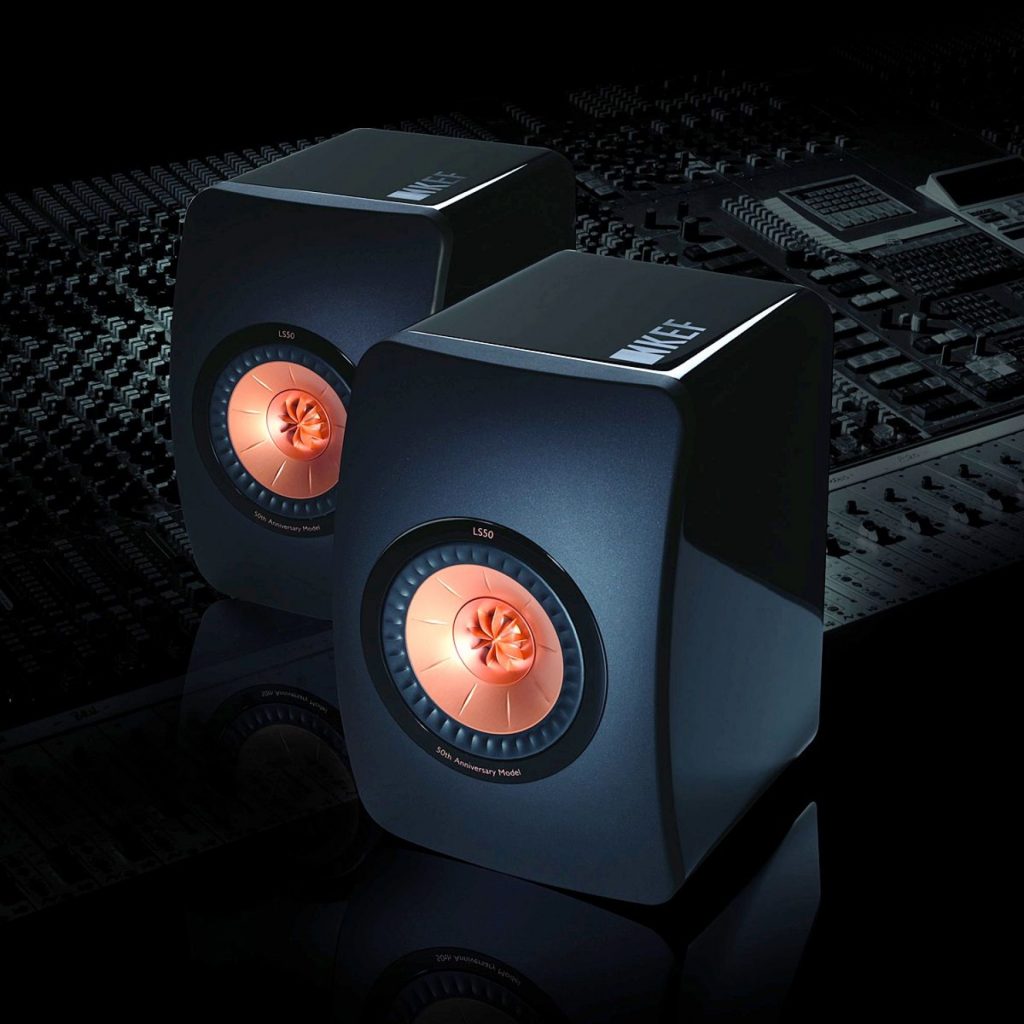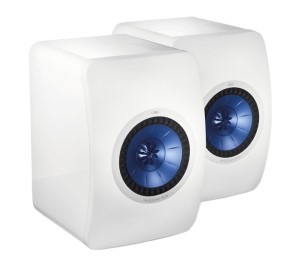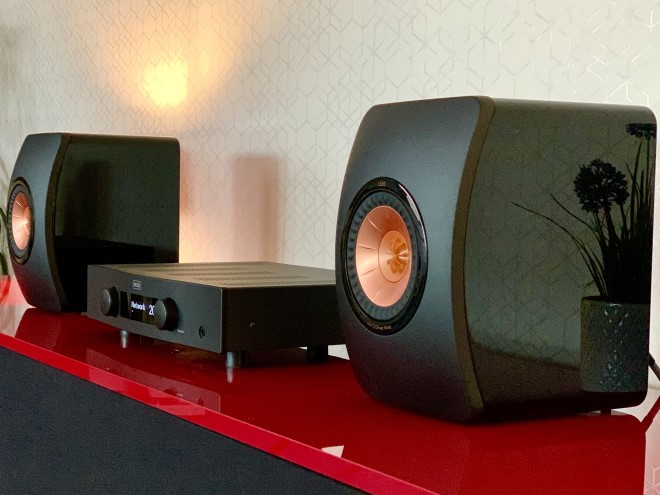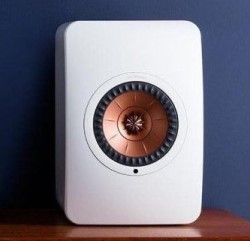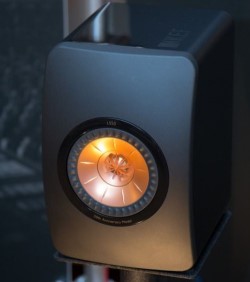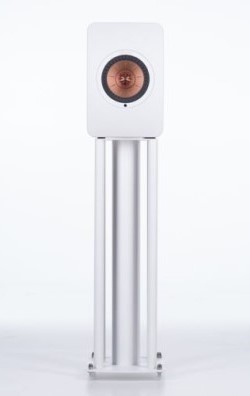The KEF LS50 mini-monitor won many awards starting in 2012 with the Best Design Award from the Japan Institute of Design and the Product of the Year Award in 2013 from publications such as What Hi-Fi? Sound & Vision, Top High End, and SoundStage Hifi! These monitors subsequently won awards for innovation through 2016 and continue to be popular to this day.
Your Best Deal
KEF LS50 Monitors
What is it like?
- Produces a large tuning sweet spot
- Ensures a clean and expansive sound
- Reproduces audio unaltered
- Four classy colors
Killer feature: Accuracy.
Let’s explore more and find out how it compares to its nearest competitors.
In 2012, KEF celebrated its 50th anniversary by the release of the KEF LS50 mini-monitor. The KEF LS50 mini-monitor continued the previous model’s innovation by using the Uni-Q driver units and the crossover from the LS3/5a model. This monitor is an engineered loudspeaker and designed to provide an accurate reproduction of the sound from a speaker housed in a small enclosure.
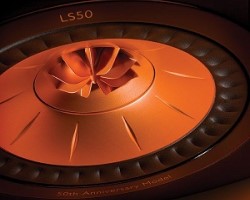
The breakthrough technology of the KEF LS50 mini-monitor comes from its cabinet construction, port design, and baffle shape with constrained layer damping that greatly reduces resonance. The port optimization derives from computations based on fluid dynamics that create less turbulence at higher volume levels.
The low-frequency/mid-frequency cone is made of an alloy made of magnesium and aluminum. The high-frequency unit is rear vented. All these detailed design elements create excellent sound definition, clarity, and imaging from an amazingly small enclosure. The first version of the KEF LS50 mini-monitor came in a high-gloss black enamel cabinet with a stunning rose-gold Uni-Q driver. Later, a white gloss color was added.
Check out the video from KEF International about the release of the LS50 model, it shows the beauty and elegance of this monitor. Using the pioneering Blade technology, which was originally invented to meet the stringent requirements of the BBC, the KEF LS50 is a professionally sounding monitor for the home recording studio.
In the 1970s, KEF worked with the BBC to develop the previous model of the LS3/5a studio speaker as an engineered monitor speaker that has accurate sound reproduction The LS50 model brings this innovation to the home studio. The challenge was to get an accurate representation of the original spacious sound with all the exciting feeling of a live performance.
The three technological breakthroughs of the LS50 model are:
- Constrained Layer Damping: This damping, placed between the brace and the enclosure walls and the baffle in front, prevents cabinet vibration that could otherwise color the mid-range sound
- Curved Baffle: The curved baffle’s shape allows the sound waves to spread out from the drive unit with minimal reflection from the edges to give a spacious sound. The baffle curvature also increases the rigidity. This reduces vibration.
- Elliptical Reflex Port: The port tube has a flexible wall that allows the mid-range sound traveling through the tube to escape back into the cabinet preventing longitudinal resonance that might otherwise radiate adding unwanted color to the mid-range sound. The port tube has flared walls to avoid the chuffing noises that might arise from air turbulence in the port tube.
Construction
Here are some of the particulars regarding the design, features, Uni-Q driver array, and size of the LS50.
The driver technology from the previous Blade technology was the basis for the development of the Uni-Q driver for the LS50. It has a tangerine waveguide with an optimal dome shape to create a spherical wavefront. This works together with the Z-flex surround to create a wide tweeter sound dispersion. The result is a very spacious sound with a wide sweet spot.
The stiffened dome of the high-frequency unit has a mid-range cone made of Mg/Al alloy. These diaphragms move as rigid pistons with the break-up control of the mid-range unit allowing an accurate, clean sound.
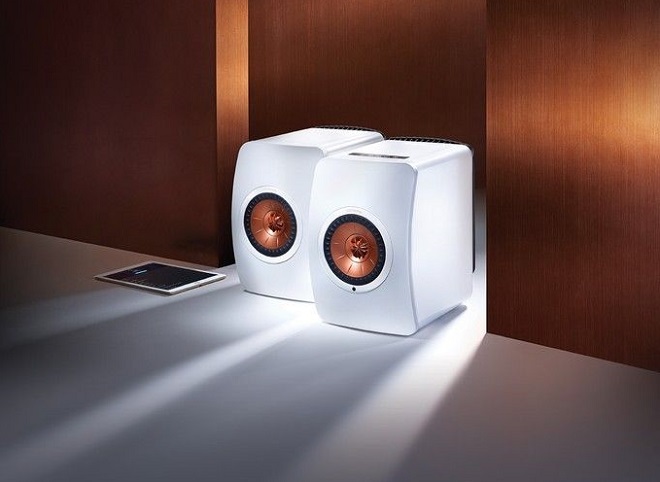
The engineering advancements came from using the Finite Element method for the modeling of the vibrations and how the air behaves inside the cabinet, the Boundary Element for modeling the sound radiation outside the cabinet, and Computational Fluid Dynamics to evaluate the airflow through the reflex port.
These modeling techniques let the engineers see how the cabinet walls vibrated and how using various materials and shapes made the sound pressure change inside the enclosure. This engineering analysis ultimately resulted in a near-perfect compact bookshelf-sized (D10.9″ x W7.9″ x H11.9″) design.
Check out the video from KEF America that explains the innovative Uni-Q driver array technology. Rather than having a separate woofer speaker for the low notes and a tweeter for the mid/high notes, as is found in other speaker designs, the Uni-Q design puts the tweeter in the exact acoustic center of the woofer speaker.
Sound Quality
The Uni-Q design means that all sound frequencies come from one physical point in space and time. This more closely resembles how sound is experienced from an original source. It also allows the sound to be more widely dispersed. The main benefit of this design is, no matter where a person is in the room, it is possible to hear a great stereo image of the sound.
Here are the pros and the cons of the LS50:
Pros
- Design: One of the main reason with the LS50 won so many awards is due to its elegant design. These monitors are museum quality and absolutely gorgeous. If you want to impress clients these are the monitors to have.
- Sound Quality: With a frequency range of 47 Hz to 45 kHz, the LS50 model covers all the sound frequencies that a human ear can register. The bass response is surprisingly robust. The Uni-Q placement of the tweeter in the center of the woofer creates a magnificent sound that has a wide dispersion and large sweet spot. This gives an accurate sound reproduction that is very enjoyable to hear from anywhere in the room.
- Durable: KEF products are made for high-end users with no skimping on quality materials. The manufacturer offers a five-year warranty against any defects.
- Compact: The bookshelf size of 10.9 inches by 7.9 inches by 11.9 inches allows these speakers to be hung from walls, placed easily on a tabletop/desk, or mounted on stands.
Cons
- Price: These are not budget speakers. They are expensive; however, I obviously think they are worth the price.
- Wired: The standard LS50 model is a wired speaker. If you want a wireless solution you will have to go for the LS50 Nocturne series.
KEF LS50 Specifications
- Model: KEF LS50
- Style: The design is a two-way bass reflex.
-
Its Uni-Q driver array ensures a clean and expansive sound. Driver: The driver is a Uni-Q array with a high-frequency 25 mm (one inch) vented-aluminum dome and a concentrically installed magnesium/aluminum alloy low/mid-frequency 130 mm (5.25 inches) dome.
- Frequency Response (±3 dB): 79 Hz to 28 kHz.
- Frequency Range (-6 dB): 47 Hz to 45 kHz.
- Sensitivity (2.83 volts/m) 85 dB.
- Crossover Frequency: 2.2 kHz.
- Amplifier Power: 25 to 100 watts.
- Maximum Output: 106 dB.
- Harmonic Distortion 2nd and 3rd harmonics (90 dB, one meter): Less than 0.4% 175 Hz to 20 kHz.
- Impedance: 8 Ω (min. 3.2 Ω).
- Weight: 7.2 kg (15.8 lbs.).
- Dimensions w/terminal (H x W x D): 302 mm x 200 mm x 278 mm (11.9” x 7.9” x 10.9”)
Comparisons to Other Monitors
Let’s take a look at how the KEF LS50 compares to a few other monitors in this class.
KEF LS50 vs. SVS Ultra Bookshelf
Here is a comparison of the specifications between the KEF LS50 monitor versus the SVS Ultra Bookshelf monitor.
- Drivers: Both of these monitors have two-way speakers. The LS50 has a one-inch (2.54 cm) vented-dome tweeter installed in the acoustic center of a 5.35-inch (13.59 cm) magnesium/aluminum alloy woofer. The SVS Ultra has a one-inch (2.54 cm) aluminum hard-dome tweeter and a separate 6.5-inch (16.51 cm) composite glass/fiber woofer. The “sweet spot” of the LS 50, where it sounds nice in the room, is slightly wider than the SVS Ultra.
- Frequency Response: The LS50 frequency range is 79 Hz to 28 kHz. The SVS Ultra frequency range is greater at 45 Hz to 32 kHz. The maximum frequency range of human hearing is 20 Hz to 20 kHz. People can “feel” low frequencies down to 20 Hz so the SVS Ultra, with its slightly better low-end, may sound better to some people. The extra frequencies above 20 kHz may be heard by dogs but humans do not hear them.
“An innovative concept inspired by the legendary LS3/5a, the LS50 mini monitor speaker is designed to bring a professional studio monitor concept into the home.” – KEF - Impedance: The impedance is the same, at eight ohms, for both of these monitors.
- Sensitivity: The sensitivity of the LS50 is 85 dB. For the SVS Ultra, it is 87 dB. Sensitivity is the sound level where the speakers work the best. Higher sensitivity creates louder speaker volume. Having sensitivity above 90 dB is excellent. The average sensitivity for all monitors is 87 to 88 dB. The LS50 sensitivity is slightly below average, whereas the SVS Ultra’s sensitivity is slightly better than the LS50 and meets the average specifications of other monitors.
- Power Range: The power range of the LS50 is 25 to 100 watts. The power range of the SVS Ultra is 20 to 150 watts, allowing them to be louder.
-
“Although some manufacturers have flirted with solutions such as this before, none has executed it as spectacularly as KEF.” – What Hi-Fi? Hall of Fame: 2010s Input Type: Bi-amping or bi-wiring is not possible with the single post on the LS50. The SVS Ultra has a five-way post that allows for bi-amping or bi-wiring. Bi-amping allows using two different amps. One is for the low frequencies. Another is for the mid-to-high frequencies. This does not increase volume much; however, the stronger amping increases the signal strength to improve the sound clarity with a cleaner, more solid bass sound, and more details in the high frequencies.
- Size: The LS50 is smaller with the dimensions of 302 mm height by 200 mm width by 278 mm depth (11.9” x 7.9” x 10.9”). The dimensions of the SVS Ultra are 379 mm height by 216 mm width by 282 mm depth (14.9” x 8.5” x 11.1”).
- Weight: The LS50 is lighter with a weight of 7.2 kg (15.8 lbs.) compared to the SVS Ultra at 8.6 kg (19 lbs.).
- Finish: The finish on the LS50 is polymer/lacquer. Most think this is a nicer finish than the SV Ultra finish of MDF/Oak veneer.
- Colors: The LS50 comes in black and high-gloss piano black or piano white. The SVS Ultra comes in plain black or white.
- Stand Height: The recommended stand height for the LS50 is 46 cm to 71 cm (18 to 28 inches) and for the SVS Ultra is 56 cm to 71 cm (22 to 28 inches).
- Warranty: Both of these monitors have a five-year, parts and labor, warranty against manufacturing defects.
KEF LS50 vs. ELAC Uni-fi UB5
Here is a direct comparison of the specifications between the KEF LS50 monitor versus the SELAC Uni-fi UB5 monitor.
- Drivers: The LS50 has two-way speakers. The SELAC Uni-fi UB5 has three-way speakers. The LS50 has a one-inch (2.54 cm) vented-dome tweeter installed in the acoustic center of a 5.35-inch (13.59 cm) magnesium/aluminum alloy woofer. The SELAC Uni-fi UB5 has a one-inch (2.54 cm) aluminum soft-dome concentrically mounted tweeter with a 4.0-inch (10.16 cm) midrange aluminum cone and a separate 5.25-inch (13.34 cm) aluminum cone woofer.
- Frequency Response: The LS50 frequency range is 79 Hz to 28 kHz. The SELAC Uni-fi UB5 frequency range is 46 Hz to 25 kHz.
- Impedance: The impedance is eight ohms for the LS50 and four ohms for the SELAC Uni-fi UB5. Due to the lower impedance, the SELAC Uni-fi UB5 will extract about twice the power from an amplifier as the LS50.
- Sensitivity: The sensitivity of both the LS50 and the SELAC Uni-fi UB5 is 85 dB.
-
“It is rare to find a loudspeaker that offers this combination of clarity and neutrality” – Stereophile Product of the Year Awards 2013 Power Range: The power range of the LS50 is 25 to 100 watts. The power range of the SELAC Uni-fi UB5 is 40 to 140 watts, allowing the SELAC Uni-fi UB5 speakers to be louder.
- Input Type: Bi-amping or bi-wiring is not possible with the single post on the LS50. The SELAC Uni-fi UB5 has a five-way post that allows for bi-amping or bi-wiring. Bi-amping allows using two different amps. One is for the low frequencies. Another is for the mid-to-high frequencies.
- Size: The LS50 has the dimensions of 302 mm height by 200 mm width by 278 mm depth (11.9” x 7.9” x 10.9”). The dimensions of the SELAC Uni-fi UB5 are very similar to the LS50 with 325 mm height by 201 mm width by 274 mm depth (12.8” x 7.9” x 10.8”).
- Weight: The LS50 is much lighter with a weight of 7.2 kg (15.8 lbs.) compared to the SELAC Uni-fi UB5 at 16.3 kg (35.9 lbs.), which is more than double the weight.
- Finish: The finish on the LS50 is polymer/lacquer. Most think this is a nicer finish than the SELAC Uni-fi UB5 finish of black, brushed vinyl.
- Colors: The LS50 comes in black and high-gloss piano black or piano white. The SELAC Uni-fi UB5 comes in plain black.
- Stand Height: The recommended stand height for the LS50 is 46 cm to 71 cm (18 to 28 inches) and for the SELAC Uni-fi UB5, the recommendation is a heavy, sturdy stand of 61 cm to 79 cm (24 to 31 inches) height.
- Warranty: The S50 has a five-year, parts and labor, warranty against manufacturing defects. The parts and labor warranty for the SELAC Uni-fi UB5 is ten years.
KEF LS50 vs. KEF R300
The KEF 2R300 is a bigger speaker from KEF that provides more bass volume.
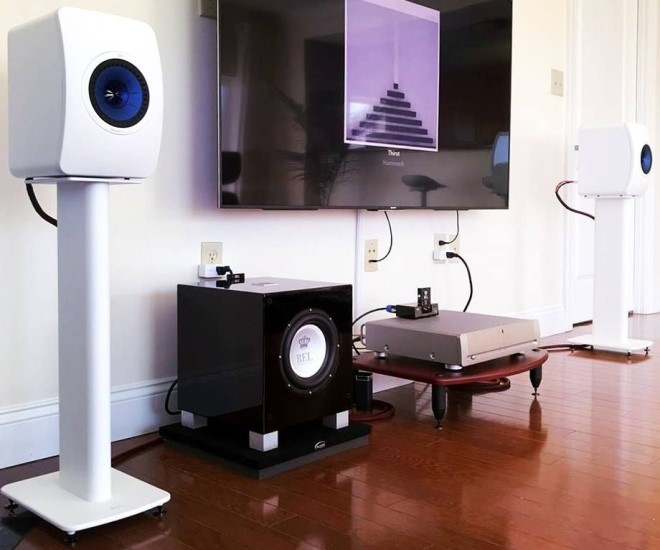
- Drivers: The LS50 has two-way speakers. The KEF R300 has three-way speakers. The LS50 has a one-inch (2.54 cm) vented-dome tweeter installed in the acoustic center of a 5.35-inch (13.59 cm) magnesium/aluminum alloy woofer. The KEF R300 has a one-inch (2.54 cm) aluminum dome concentrically mounted tweeter with a 5.0-inch (12.70 cm) midrange magnesium/aluminum cone and a separate 6.5-inch (15.24 cm) aluminum cone woofer.
- Frequency Response: The LS50 frequency range is 79 Hz to 28 kHz. The KEF R300 frequency range is 50 Hz to 28 kHz giving it a stronger bass response.
- Impedance: The impedance is eight ohms for the LS50 and the KEF R300.
-
“…we think you’ll struggle to find a better balanced system unless you spend thousands more.” – Hi-Fi + Value-Priced Loudspeaker of the Year Sensitivity: The sensitivity of the LS50 is 85 dB and the KEF R300 is 88 dB allowing more speaker volume for the KEF R300 model.
- Power Range: The power range of the LS50 is 25 to 100 watts. The power range of the KEF R300 is 25 to 120 watts, allowing the KEF R300 speakers to be louder.
- Input Type: Bi-amping or bi-wiring is not possible with the single post on the LS50. The KEF R300 has two sets of input terminals that allow for bi-amping or bi-wiring. Bi-amping allows using two different amps. One is for the low frequencies. Another is for the mid-to-high frequencies.
- Size: The LS50 has the dimensions of 302 mm height by 200 mm width by 278 mm depth (11.9” x 7.9” x 10.9”). The dimensions of the KEF R300 are larger than the LS50 with 389 mm height by 203 mm width by 340 mm depth (15.3” x 8.3” x 13.4”).
- Weight: The LS50 is much lighter with a weight of 7.2 kg (15.8 lbs.) compared to the KEF R300 at 12.0 kg (26.4 lbs.).
- Finish: The finish on both the LS50 and the KEF R300 is polymer/lacquer for the glossy finishes. The KEF R300 also has a walnut veneer finish offered.
- Colors: The LS50 comes in black and high-gloss piano black or piano white. The KEF R300 comes in high-gloss piano black or piano white and walnut.
- Stand Height: The recommended stand height for the LS50 is 46 cm to 71 cm (18 to 28 inches) and for the KEF R300, the recommendation is a sturdier stand of 61 cm to 79 cm (24 to 31 inches) height.
- Warranty: Both the S50 and the KEF R300 have a five-year, parts and labor, warranty against manufacturing defects.
User Reviews
User reviews are very positive for the LS50, with almost everyone giving close to the perfect score of five stars.
Typical reviewers say things like this:
I could listen to the LS50 speakers all day and never tire of the excellent sound. Robert
These monitors are expensive so I had to save up for them. I am really happy that I did and will never go back to using cheap speakers in my home recording studio again. Victor
I have been extremely pleased with the sound of my LS50 monitors that I use daily when creating YouTube videos in my home studio. Lucy
Your Best Deal
KEF LS50 Monitors
What is it like?
- Produces a large tuning sweet spot
- Ensures a clean and expansive sound
- Reproduces audio unaltered
- Four classy colors
Killer feature: Accuracy.
Conclusion
By far, the LS50 is my favorite choice for a high-quality monitor in this compact bookshelf size. If you are a serious audiophile like me, you will fall in love with the sound of these monitors. They are worth the price and will give many years of excellent use. They are especially useful in a smaller home studio.
If you want to explore more choices for home studio monitors be sure to check out the reviews of my 19 top home studio monitors.

